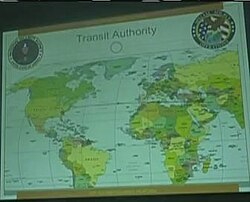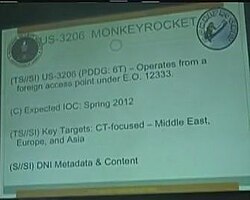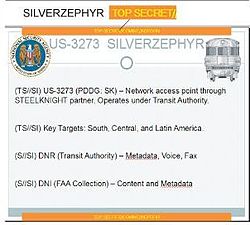 National Security Agency surveillance |
|---|
 |
OAKSTAR is a secret internet surveillance program of the National Security Agency (NSA) of the United States. It was disclosed in 2013 as part of the leaks by former NSA contractor Edward Snowden.
Contents
OAKSTAR is an umbrella program involving surveillance of telecommunications. It falls under the category of "Upstream collection", meaning that data is pulled directly from fiber-optic cables and top-level communications infrastructure. [1] [2] Upstream collection programs allow access to very high volumes of data, and most of the pre-selection is done by the providers themselves, before the data is passed on to the NSA.
The FY 2013 budget for OAKSTAR was $9.41 million. [3] OAKSTAR consists of the following SIGADs:
| Designation | Covername | Legal AuthoritySee Note | Key Targets | Type of Information collected | Remarks |
|---|---|---|---|---|---|
| US-3206 (PDDG:6T) | MONKEYROCKET | Executive Order 12333 | Counterterrorism in the Middle East, Europe, and Asia | DNI metadata and content | "Foreign access point," was expected to go online in spring 2012 |
| US-3217 (PDDG:MU) | SHIFTINGSHADOW | Afghanistan communications: MTN Afghanistan, Roshan GSM Network, AWCC | DNR metadata and voice; "Timing Advances" and geolocation | "Foreign access point" | |
| US-3230 (PDDG:0B) | ORANGECRUSH | "To be determined" | Voice, fax, DNI, DNR, and metadata | "Foreign access point through PRIMECANE, and 3rd party partner", not online as of the time of source presentation. | |
| US-3247 (PDDG:PJ) | YACHTSHOP | Worldwide DNI Metadata | Worldwide DNI Metadata | "Access through BLUEANCHOR partner," contributor to MARINA | |
| US-3251 | ORANGEBLOSSOM | ||||
| US-3273 (PDDG:SK) | SILVERZEPHYR | Transit Authority and FAA | South, Central and Latin America | DNR Metadata, voice and fax; DNI content and metadata | "Network access point through STEELKNIGHT partner" |
| US-3277 | BLUEZEPHYR | ||||
| US-3354 | COBALTFALCON |
Note: SIGADs not otherwise designated are presumed[ by whom? ] to operate under the legal authority of Section 702 of the FISA Amendments Act (FAA)









